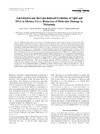Identificador persistente para citar o vincular este elemento:
https://accedacris.ulpgc.es/jspui/handle/10553/76970
| Campo DC | Valor | idioma |
|---|---|---|
| dc.contributor.author | Cabrera, Javier | en_US |
| dc.contributor.author | Burkhardt, Susanne | en_US |
| dc.contributor.author | Tan, Dun-Xian | en_US |
| dc.contributor.author | Manchester, Lucien C. | en_US |
| dc.contributor.author | Karbownik, Malgorzata | en_US |
| dc.contributor.author | Reiter, Russel J. | en_US |
| dc.date.accessioned | 2020-12-23T16:50:45Z | - |
| dc.date.available | 2020-12-23T16:50:45Z | - |
| dc.date.issued | 2001 | en_US |
| dc.identifier.issn | 0901-9928 | en_US |
| dc.identifier.other | WoS | - |
| dc.identifier.uri | https://accedacris.ulpgc.es/handle/10553/76970 | - |
| dc.description.abstract | Melatonin, the main secretory product of the pineal gland, is a free radical scavenger and antioxidant which protects against oxidative damage due to a variety of toxicants. However, there is little information regarding melatonin's antioxidative capacity in tissues of primates. In this study we examined the protective effects of melatonin in monkey liver homogenates against lipid damage that occurred as a result of autoxidation or that induced by exogenous addition of H2O2 and ferrous iron (Fe2+). Additionally, we tested melatonin's protective effect against oxidative damage to DNA induced by chromium(III) (CrIII) plus H2O2. The levels of malondialdehyde and 4-hydroxyalkenals were assayed as an index of lipid peroxidation, and the concentrations of 8-hydroxydeoxyguanosine (8-OHdG) as an endpoint of oxidative DNA damage. The increases in malondialdehyde+4-hydroxyalkenals concentrations as a consequence of autoxidation or after the addition of H2O2 plus Fe2+ to the homogenates were time-dependent. The accumulation of these damaged products due to either autoxidative processes or induced by H2O2 and Fe2+ were significantly reduced by melatonin in a concentration-dependent-manner. The levels of 8-OHdG were elevated in purified monkey liver DNA incubated with a combination of CrCl3 plus H2O2. This rise in oxidatively damaged DNA was prevented by 10 muM concentration of melatonin. Also, melatonin reduced the damage to DNA that was caused by autoxidative processes. These findings in monkey liver tissue document the ability of melatonin to protect against oxidative damage to both lipid and DNA in primate tissue, as observed previously in rodent tissue. The findings provide support for the use of melatonin as suitable agent to reduce damage inflicted by free radical species in primates. | en_US |
| dc.language | eng | en_US |
| dc.relation.ispartof | Pharmacology and Toxicology | en_US |
| dc.source | Pharmacology and Toxicology [ISSN 0901-9928], v. 89 (5), p. 225-230, (Noviembre 2001) | en_US |
| dc.subject | 3209 Farmacología | en_US |
| dc.subject.other | Pineal Hormone Melatonin | en_US |
| dc.subject.other | Antioxidants | en_US |
| dc.subject.other | Toxicology | en_US |
| dc.subject.other | Pharmacology | en_US |
| dc.title | Autoxidation and toxicant-induced oxidation of lipid and DNA in monkey liver: Reduction of molecular damage by melatonin | en_US |
| dc.type | info:eu-repo/semantics/Article | en_US |
| dc.type | Article | en_US |
| dc.identifier.doi | 10.1111/j.1600-0773.2001.890502.x | en_US |
| dc.identifier.pmid | 11881975 | - |
| dc.identifier.scopus | 0035161021 | - |
| dc.identifier.isi | 000172324900002 | - |
| dc.contributor.authorscopusid | 35598975600 | - |
| dc.contributor.authorscopusid | 7005545056 | - |
| dc.contributor.authorscopusid | 7202902017 | - |
| dc.contributor.authorscopusid | 7004415929 | - |
| dc.contributor.authorscopusid | 7003978133 | - |
| dc.contributor.authorscopusid | 7402574751 | - |
| dc.description.lastpage | 230 | en_US |
| dc.identifier.issue | 5 | - |
| dc.description.firstpage | 225 | en_US |
| dc.relation.volume | 89 | en_US |
| dc.investigacion | Ciencias de la Salud | en_US |
| dc.type2 | Artículo | en_US |
| dc.contributor.daisngid | 240124 | - |
| dc.contributor.daisngid | 9418589 | - |
| dc.contributor.daisngid | 172574 | - |
| dc.contributor.daisngid | 350294 | - |
| dc.contributor.daisngid | 409917 | - |
| dc.contributor.daisngid | 7060708 | - |
| dc.description.numberofpages | 6 | en_US |
| dc.utils.revision | Sí | en_US |
| dc.contributor.wosstandard | WOS:Cabrera, J | - |
| dc.contributor.wosstandard | WOS:Burkhardt, S | - |
| dc.contributor.wosstandard | WOS:Tan, DX | - |
| dc.contributor.wosstandard | WOS:Manchester, LC | - |
| dc.contributor.wosstandard | WOS:Karbownik, M | - |
| dc.contributor.wosstandard | WOS:Reiter, RJ | - |
| dc.date.coverdate | Enero 2001 | en_US |
| dc.identifier.ulpgc | Sí | en_US |
| dc.description.jcr | 0,925 | |
| dc.description.jcrq | Q3 | |
| item.grantfulltext | open | - |
| item.fulltext | Con texto completo | - |
| Colección: | Artículos | |
Citas SCOPUSTM
21
actualizado el 08-jun-2025
Citas de WEB OF SCIENCETM
Citations
20
actualizado el 25-feb-2024
Visitas
123
actualizado el 31-may-2025
Descargas
190
actualizado el 31-may-2025
Google ScholarTM
Verifica
Altmetric
Comparte
Exporta metadatos
Los elementos en ULPGC accedaCRIS están protegidos por derechos de autor con todos los derechos reservados, a menos que se indique lo contrario.
